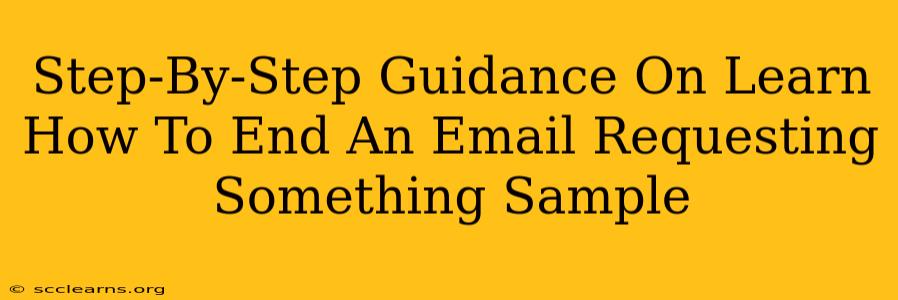Ending an email professionally, especially one requesting something, is crucial for securing a positive response. A strong closing leaves a lasting impression and increases your chances of getting what you need. This guide provides a step-by-step approach to crafting effective email closings for various situations.
Understanding the Importance of a Strong Email Closing
The closing of your email is not just a formality; it's your final opportunity to make a positive impact. A poorly written closing can undermine the entire email, leaving a negative impression and potentially jeopardizing your request. A well-crafted closing, however, reinforces your professionalism, reiterates your request subtly, and encourages a timely response.
Key Elements of an Effective Email Closing:
- Professionalism: Maintain a polite and respectful tone throughout, avoiding overly casual or demanding language.
- Clarity: Reiterate your call to action concisely and clearly.
- Gratitude: Express appreciation for the recipient's time and consideration.
- Contact Information: Provide your contact details for easy follow-up.
Step-by-Step Guide to Closing Your Email Request
Here's a practical step-by-step guide to help you end your email request effectively:
Step 1: Express Gratitude
Begin your closing by expressing your sincere appreciation for the recipient's time and consideration. Avoid generic phrases like "Thanks" and instead opt for more personalized expressions:
- "Thank you for your time and consideration of my request."
- "I appreciate you taking the time to review my request."
- "Thank you for your assistance in this matter."
Step 2: Reiterate Your Call to Action (Subtly)
Subtly reiterate your request without sounding demanding. This serves as a gentle reminder of what you need. Avoid overly assertive language. Instead, use phrases like:
- "I look forward to hearing from you soon regarding my request."
- "Please let me know if you require any further information."
- "I would appreciate it if you could respond by [date]."
Step 3: Provide Contact Information (If Necessary)
If you haven't already included your contact information in the email's header or signature, provide it again in the closing. This makes it easy for the recipient to contact you with questions or updates.
Step 4: Choose a Professional Closing Salutation
Select a professional closing salutation that aligns with your relationship with the recipient and the overall tone of the email. Here are a few options:
- Sincerely, (Classic and widely accepted)
- Regards, (Slightly less formal than "Sincerely")
- Best regards, (Suitable for most professional contexts)
- Kind regards, (Warm and friendly)
Step 5: Proofread Carefully
Before sending your email, thoroughly proofread the closing and the entire email for any grammatical errors, typos, or inconsistencies. A well-polished email reflects your professionalism and attention to detail.
Sample Email Closings
Here are a few sample email closings incorporating the steps above:
Example 1 (Formal):
Thank you for your time and consideration of my request for a meeting. I look forward to hearing from you soon regarding the availability of a time that works for both of us. Please let me know if you require any further information.
Sincerely,
[Your Name]
Example 2 (Semi-Formal):
I appreciate you taking the time to review my request for budget approval. I would appreciate it if you could respond by Friday, October 27th. You can reach me at [phone number] or [email address] if you have any questions.
Best regards,
[Your Name]
Example 3 (Informal, but still professional):
Thanks for considering my request for additional project resources. Let me know if you need anything else from me.
Regards,
[Your Name]
By following these steps, you can craft professional and effective email closings that significantly improve your chances of receiving a positive response to your requests. Remember to tailor your closing to each situation and recipient for optimal results. The key is to be polite, clear, and appreciative.

